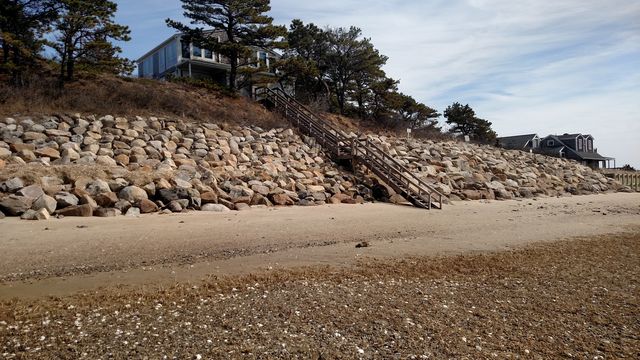

Beaches along our shorelines erode not only from loss of sand due to the forces of coastal storms, but also from sea level rise. With 50% of our population residing by or near coasts and seaports — and visits to beaches the #1 tourist destination in the U.S. — the effects of rising sea levels are of major concern to all of us.
Although there is agreement among scientists that the melting of continental glaciers through global warming is contributing to this rise in sea level, there are differences of opinion regarding the predicted amount of rise and the timeframe in which it will occur. One recent report from the Intergovernmental Panel on Climate Change (IPCC) predicted the rate of sea level rise for this century to be about 1.5’, which is twice the rate of increase during the 20th century.
Moreover, the effects of tidal changes due to nature’s modification of coastal beach systems are far more likely to have adverse effects on our shorelines than the effects of sea level rise from global warming.

Sea-level rise is accelerating beach erosion throughout all of coastal New England and is predicted to be twice the rate of increase experienced during the 20th century.
Faced with rising sea levels, shoreline protection measures not only provide a sense of security for waterfront homeowners, but also maintain our beaches for recreational purposes, restore natural wildlife habitat, and provide storm protection for the infrastructure that supports significant portions of the American economy.
Both public and private shoreline properties have been gaining in value over the past years, but these higher values also come with greater environmental risks. These properties are likely to become more valuable in the future, but only with erosion control and stabilization measures in place. For this reason, a shoreline evaluation assessment — of both existing conditions and longer-term risks that may impact property values — is a worthwhile investment.
A shoreline property’s risk assessment profile includes evaluation of a number of conditions and risk factors, including:
For a minimal cost investment, this type of evaluation report can provide valuable information to assess a shoreline property’s level of risk for experiencing adverse environmental conditions, such as coastal erosion and predicted storm surge. The report can also be used to estimate the time remaining for any existing structures — based on the average erosion rates in that location — or to evaluate the possibility of moving those structures further away from any coastal threats.

A shoreline property’s risk assessment profile includes evaluation of a number of conditions and risk factors.
There are a number of shoreline bank stabilization methods that can be designed and implemented, although some options may be limited by various state and local regulations. In Massachusetts, any shorefront stabilization projects need to be designed by licensed engineers to meet state building code standards. Also, wetland regulations do not allow protection of a property unless it is deemed to be threatened by coastal erosion by the local Conservation Commission. Aside from areas under federal jurisdiction (such as in the National Seashore), if a coastal dwelling is considered to be within 20-30 years of erosion at average erosion rates for that area, then some degree of shoreline protection can be considered.
Though many different shoreline stabilization approaches have been tried, it often takes a combination of solutions to work best. These combination approaches generally involve either a “soft” solution (plantings or fencing) or harder “armoring” (a revetment or bulkhead) — plus the addition of sand for ongoing nourishment purposes.

The shoreline stabilization methods that work best involve a combination of approaches.
And, because federal, state, and/or local environmental regulations stipulate the degree of shoreline protection allowed on a particular property, the best approaches would be those that do not involve state or federal permits, where possible. Although all shoreline projects must obtain local approval, a proactive approach that keeps projects at the local level only can make the permitting process less costly and less cumbersome.
While the costs for shoreline stabilization projects are not insignificant, they are relatively inexpensive compared to what the real “value” of protecting our shorelines is worth — both economically and aesthetically.
Contact us to learn how Coastal Engineering Co. can help protect your property from erosion and keep its value in the long term.